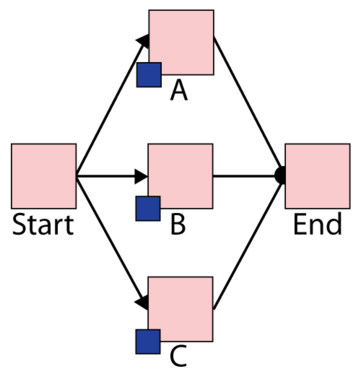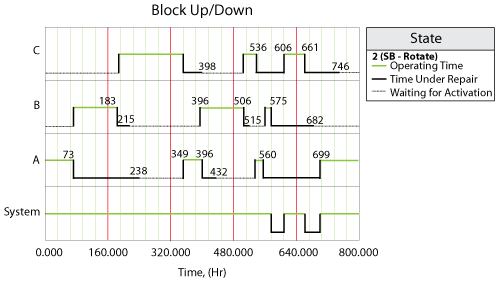Template:Rotation: Difference between revisions
(BlockSim 8 Example illustrating the use of state change triggers) |
|||
| Line 5: | Line 5: | ||
==== Purpose ==== | ==== Purpose ==== | ||
This example illustrates the use of state change triggers [http://www.reliawiki.org/index.php/BlockSim_8:_State_Change_Triggers#State_Change_Triggers SCT] in BlockSim Version 8 by using a simple | This example illustrates the use of state change triggers [http://www.reliawiki.org/index.php/BlockSim_8:_State_Change_Triggers#State_Change_Triggers SCT] in BlockSim Version 8 by using a simple standby configuration. ''Note that this example could also be done using the standby container functionality in BlockSim.'' | ||
More specifically the following settings are illustrated: | More specifically the following settings are illustrated: | ||
| Line 14: | Line 14: | ||
==== Statement ==== | ==== Statement ==== | ||
Assume three devices A, B and C in a standby redundancy (or only one unit is needed for system operation). The system begins with device A working. When device A fails B is turned on and repair actions | Assume three devices A, B and C in a standby redundancy (or only one unit is needed for system operation). The system begins with device A working. When device A fails B is turned on and repair actions initiated on A. When B fails C is turned on and so forth. | ||
| Line 20: | Line 20: | ||
==== BlockSim Solution ==== | ==== BlockSim Solution ==== | ||
The | The BlockSim model of this system is shown in the Figure below. | ||
[[Image:Blocksim Example Rotation example.png|thumb|center|361px]] | [[Image:Blocksim Example Rotation example.png|thumb|center|361px]] | ||
| Line 59: | Line 59: | ||
The system event log is shown Block Up/Down plot below, for a single run through the simulation algorithm and is as follows: | The system event log is shown Block Up/Down plot below, for a single run through the simulation algorithm and is as follows: | ||
#At 73, Block A fails and activates Block B. | #At 73, Block A fails and activates Block B. | ||
#At 183, Block B fails and activates Block C. | #At 183, Block B fails and activates Block C. | ||
#At 215, Block B is done with repair. At this time, Block C is operating, according to setting, Block B is standby. | |||
#At 238, Block A is done with repair. At this time, Block C is operating. Thus Block A is standby. | #At 215, Block B is done with repair. At this time, Block C is operating, according to setting, Block B is standby. | ||
#At 238, Block A is done with repair. At this time, Block C is operating. Thus Block A is standby. | |||
#At 349, Block C fails and activates Block A. | #At 349, Block C fails and activates Block A. | ||
#At 396, Block A fails and activates Block B. | #At 396, Block A fails and activates Block B. | ||
#At 398, Block C is done with repair. At this time, Block B is operating. Thus Block C is standby. | #At 398, Block C is done with repair. At this time, Block B is operating. Thus Block C is standby. | ||
#At 432, Block A is done with repair. At this time, Block B is operating. Thus Block A is standby. | #At 432, Block A is done with repair. At this time, Block B is operating. Thus Block A is standby. | ||
#At 506, Block B fails and activates Block C. | #At 506, Block B fails and activates Block C. | ||
#At 515, Block B is done with repair and keep standby because Block C is operating. | #At 515, Block B is done with repair and keep standby because Block C is operating. | ||
#At 536, Block C fails and active Block A. | #At 536, Block C fails and active Block A. | ||
#At 560, Block A fails and active Block B. | #At 560, Block A fails and active Block B. | ||
#At 575, Block B fails and put a | |||
#At 661, Block C fails and put a request to active Block A. However, Block A is under repair at the time. Thus when Block A is done with repair at 699, the OFF setting is overwritten and it is operating | #At 575, Block B fails and put a request to active Block C. However, Block C is under repair at the time. Thus when Block C is done with repair at 606, the OFF setting is overwritten and it is operating immediately | ||
#At 661, Block C fails and put a request to active Block A. However, Block A is under repair at the time. Thus when Block A is done with repair at 699, the OFF setting is overwritten and it is operating immediately. | |||
#Block B and Block C are done with repair at 682 and at 746 respectively. However, at these two time point, Block A is operating. Thus they are both standby upon repair according to settings. | #Block B and Block C are done with repair at 682 and at 746 respectively. However, at these two time point, Block A is operating. Thus they are both standby upon repair according to settings. | ||
Revision as of 01:26, 25 September 2011
Standby Rotation Example
Purpose
This example illustrates the use of state change triggers SCT in BlockSim Version 8 by using a simple standby configuration. Note that this example could also be done using the standby container functionality in BlockSim.
More specifically the following settings are illustrated:
- State Upon Repair: Default OFF unless SCT overridden
- Activate a block if any item from these associated maintenance group(s) goes down
Statement
Assume three devices A, B and C in a standby redundancy (or only one unit is needed for system operation). The system begins with device A working. When device A fails B is turned on and repair actions initiated on A. When B fails C is turned on and so forth.
BlockSim Solution
The BlockSim model of this system is shown in the Figure below.
- The failure distributions of all three blocks follow Weibull distribution with Beta = 1.5 and Eta = 1,000.
- The repair distribution of three blocks also follows Weibull distribution with Beta = 1.5 and Eta = 100.
- After repair, they are "as good as new".
There are three maintenance groups, 2_A, 2_B and 2_C set as follows:
- Block A belongs to maintenance group 2_A.
- It has state change trigger.
- The initial state is ON and the state upon repair is "Default Off Unless overridden".
- If any item from maintenance group 2_C goes down, then activate this block.
- It has state change trigger.
- Block B belongs to maintenance group 2_B.
- It has state change trigger.
- The initial state is OFF and the state upon repair is "Default Off Unless overridden".
- If any item from maintenance group 2_A goes down, then activate this block.
- It has state change trigger.
- Block C belongs to maintenance group 2_C.
- It has state change trigger.
- The initial state is OFF and the state upon repair is "Default Off Unless overridden".
- If any item from maintenance group 2_B goes down, then activate this block.
- It has state change trigger.
- All blocks A, B and C are as good as new after repair.
System Events
The system event log is shown Block Up/Down plot below, for a single run through the simulation algorithm and is as follows:
- At 73, Block A fails and activates Block B.
- At 183, Block B fails and activates Block C.
- At 215, Block B is done with repair. At this time, Block C is operating, according to setting, Block B is standby.
- At 238, Block A is done with repair. At this time, Block C is operating. Thus Block A is standby.
- At 349, Block C fails and activates Block A.
- At 396, Block A fails and activates Block B.
- At 398, Block C is done with repair. At this time, Block B is operating. Thus Block C is standby.
- At 432, Block A is done with repair. At this time, Block B is operating. Thus Block A is standby.
- At 506, Block B fails and activates Block C.
- At 515, Block B is done with repair and keep standby because Block C is operating.
- At 536, Block C fails and active Block A.
- At 560, Block A fails and active Block B.
- At 575, Block B fails and put a request to active Block C. However, Block C is under repair at the time. Thus when Block C is done with repair at 606, the OFF setting is overwritten and it is operating immediately
- At 661, Block C fails and put a request to active Block A. However, Block A is under repair at the time. Thus when Block A is done with repair at 699, the OFF setting is overwritten and it is operating immediately.
- Block B and Block C are done with repair at 682 and at 746 respectively. However, at these two time point, Block A is operating. Thus they are both standby upon repair according to settings.

